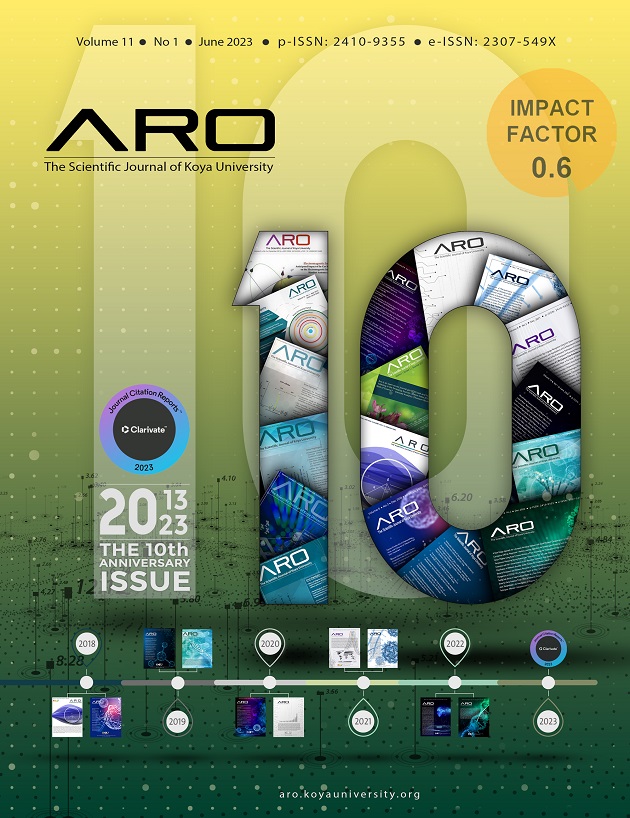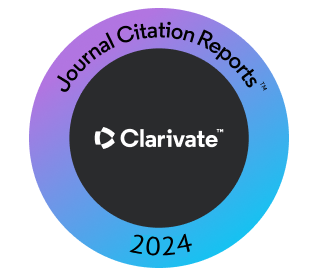Effect of Hot Glue Additive on the Rheological Properties of Asphalt Cement and Mixtures Performance
DOI:
https://doi.org/10.14500/aro.11055Keywords:
Hot glue, Silicone, Dense silicone rubber, Ethylene propylene diene monomer rubber, Modified asphalt cement, Indirect tensile strength, Marshall StiffnessAbstract
In general, the physical and rheological properties of asphalt binder are directly affecting the resistance of asphalt mix to the permanent deformation (rutting), water damage, and thermal cracking. The degradation in these properties leads to severe distresses that appear in the pavement and, consequently, make the repair and maintenance very expensive. Since the modified-asphalt cement may help to minimize such aforementioned distresses, this research is established for this purpose. It aims to investigate the physical and rheological properties of modified-asphalt cement with silicone, dense silicone rubber, and ethylene propylene diene monomer rubber. Five contents for each type of hot glue are investigated; 0.4, 0.8, 1.2, 1.6, and 2% of the asphalt cement weight. Conventional asphalt cement tests such as penetration, softening point, dynamic viscosity, and ductility tests are conducted to evaluate the hot glue-modified asphalt cement properties. Moreover, the Marshall and indirect tensile strength tests are conducted to examine the effect of hot glue on the performance of the asphalt mixtures at concentrations of 0.8 and 1.6% of the asphalt cement weight. The results show that the hot glue-modified asphalt cement leads to an increase in the hardness and consistency, and a reduction in the temperature susceptibility of asphalt cement. These features lead to better Marshall stability and tensile strength ratio, as compared with the standard asphalt cement mixture.
Downloads
References
AASHTO T283-03., 2016. Standard Method of Test for Resistance of Compacted Asphalt Mixtures to Moisture-Induced Damage. AASHTO T283-03, Washington, DC.
Al-Ani, T.M.A., 2009. Modification of asphalt mixture performance by rubbersilicone additive. Anbar Journal for Engineering Sciences, 2(1), pp. 71-81.
ASTM International., 2003, Standard Test Method for Resistance to Plastic Flow of Bituminous Mixtures Using Marshall Apparatus: Annual Book of ASTM Standards USA. ASTM D1559-89, Pennsylvania, United States.
ASTM International., 2015. Standard Test Method for Ductility of Bituminous Materials: Annual Book of Standards American Society for Testing and Materials. ASTM D113, Pennsylvania, United States.
ASTM International., 2015. Standard Test Method for Flash and Fire Points by Cleveland Open Cup Tester: Annual Book of Standards American Society for Testing and Materials. ASTM D92, Pennsylvania, United States.
ASTM International., 2015. Standard Test Method for Penetration of Bituminous Materials: Annual Book of Standards American Society for Testing and Materials. ASTM D5, Pennsylvania, United States.
ASTM International., 2015. Standard Test Method for Softening Point of Bitumen (Ring-and-Ball Apparatus): Annual Book of Standards American Society for Testing and Materials. ASTM D36, Pennsylvania, United States.
ASTM International., 2018. Standard Test Method for Viscosity of Asphalts by Vacuum: Annual Book of Standards American Society for Testing and Materials. ASTM D2171, Pennsylvania, United States.
Fernando, M.J. and Guirguis, H.R., 1983. Rubberized Asphalt in Pavement Technology for Hot Climates. Vol. 3. Association of Asia and Australasia (REAAA), Malaysia. pp. 25-43.
Khodary Moalla Hamed, F., 2010. Evaluation of Fatigue Resistance for Modified Asphalt Concrete Mixtures Based on Dissipated Energy Concepts. Department of Civil Engineering and Geodesy, Technische Universitat Darmstadt, Germany.
King, G.N. and King, H.W., 1986. Polymer Modified Asphalts, an Overview. American Society of Civil Engineering, Virginia, United States. pp. 240-254.
Kumar, A., Choudhary, R. and Kumar, A., 2019. Utilization of Waste EthylenePropylene-Diene-Monomer (EPDM) Rubber Modified Binder in Asphalt Concrete Mixtures Conference. In: 5th Conference of the Transportation Research Group of India (CTRG-2019), Bhopal, India.
Lewandowski, L.H., 1994. Polymer Modification of Paving Asphalt Binders. Rubber Chemistry and Technology, 67, pp. 435-447.
Alibaba.com. Available from: https://www.therubbercompany.com/extrusionsprofiles/solid-sponge-rubber-cords/epdm-solid-rubber-cord [Last accessed 2022 Jul 28].
The Rubber Company. Available from: https://www.alibaba.com/product-detail/Rubber-Solid-Rods-High-Temperature%20Resistant_1600069572471.html [Last accessed 2022 Jul 28].
Polymax Group. Available from: https://www.polymax.co.uk/silicone/siliconerubber-cord-solid/translucent-silicone-cord [Last accessed 2022 Jul 28].
State Organization of Road and Bridges (SORB)., 2007. Section R9, Hot-Mix Asphalt Concrete Pavement, Revised Edition by Consultant Civil Engineer Nuraddin Saeed Hussain (Issued in Iraq 1986).
Tayebali, A.A., Goodrich, J.I., Sousa, J.B. and Monismith, C.I., 1992. Influence of rheological properties of modified asphalt binders on the load deformation characteristics of the binder-aggregate mixture. In: Wardlaw, K.R. and Shuler, S., editors. ASTM STP 1108: Polymer Modified Asphalt Binders. ASTM International, United States. pp. 77-96.
Zhang, F., Yu, J. and Wu, S., 2010. Effect of aging on rheological properties of storage-stable SBS/sulfur-modified asphalts. Journal of Hazardous Materials,182, p. 507-517.
Downloads
Published
How to Cite
Issue
Section
License
Authors who choose to publish their work with Aro agree to the following terms:
-
Authors retain the copyright to their work and grant the journal the right of first publication. The work is simultaneously licensed under a Creative Commons Attribution License [CC BY-NC-SA 4.0]. This license allows others to share the work with an acknowledgement of the work's authorship and initial publication in this journal.
-
Authors have the freedom to enter into separate agreements for the non-exclusive distribution of the journal's published version of the work. This includes options such as posting it to an institutional repository or publishing it in a book, as long as proper acknowledgement is given to its initial publication in this journal.
-
Authors are encouraged to share and post their work online, including in institutional repositories or on their personal websites, both prior to and during the submission process. This practice can lead to productive exchanges and increase the visibility and citation of the published work.
By agreeing to these terms, authors acknowledge the importance of open access and the benefits it brings to the scholarly community.
Accepted 2023-02-02
Published 2023-02-20
















 ARO Journal is a scientific, peer-reviewed, periodical, and diamond OAJ that has no APC or ASC.
ARO Journal is a scientific, peer-reviewed, periodical, and diamond OAJ that has no APC or ASC.